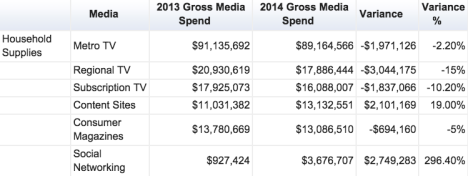Supermarket wars blamed for huge drop in FMCG ad spend
 New breakdowns in media agency client spend data for the fast moving consumer goods (FMCG) category show advertising in the area of food, produce and dairy is down almost 10 per cent year on year, Mumbrella can reveal.
New breakdowns in media agency client spend data for the fast moving consumer goods (FMCG) category show advertising in the area of food, produce and dairy is down almost 10 per cent year on year, Mumbrella can reveal.
Experts say the shift in ad dollars is likely to be driven by a renewed push by Coles and Woolworths to have their suppliers spend more on instore advertising, with much of the money coming out of traditional TV budgets.
Standard Media Index (SMI) has for the first time broken down agency spend in the area of FMCG, its third largest category, illustrating why the wider category recorded a decline of 7.6 per cent to $538.5m in 2014.
The new data suggests the supermarket war has taken a bite out of the ad market with the sub category of food/produce/dairy 9.9 per cent down from $423.2m in 2013 to $381.5m in 2014. Household supplies remaining relatively stable at around $184m.
Dr Gary Mortimer, senior lecturer at QUT’s Business School, said spend in food was down “significantly”, adding: “It would appear that the big chains are leveraging their partner’s marketing campaigns.
“I think the brands have realised that broadcast advertising is less effective than targeted messaging. The shift seems to be away from traditional broadcast and pushing it into social networking, their own databases and their own instore media.”
Deakin University lecturer in consumer marketing Michael Callaghan agreed that the shift was likely driven by the ongoing retail war between Coles and Woolworths.
“The reduction in media spend could well be indicative of the continued pressure the two big supermarkets are putting on their suppliers to cover their costs,” said Callaghan.
“It may not just be for in store promotion”, he said. “(Coles and Woolworths) have been in trouble with the ACCC for putting undue pressure on their suppliers and I think what happens is that management at the two chains go away and find another way to get the savings they want.”
SMI data shows food/produce/dairy advertising dropped spending on metropolitan television by 13 per cent last year, falling from $208.3m to $181.3m.
The hardest hit was subscription TV which suffered a 13.9 per cent decline with spend falling to $33.2m, while regional television fell 8 per cent to $28.1m.
In the area of household supplies the decline in metropolitan spend for television was only 2.2 per cent, but in regional television it fell $20.9m to $17.8m – a decline of 14.5 per cent – and subscription television fell by 10.2 per cent from $17.9m to $16m.
“With pressure going on suppliers to in effect cover the (instore) marketing they have to make savings somewhere and the reality is to take it from advertising spend,” said Callaghan.
“Suppliers are in a difficult situation where in the current market companies like Kogan are starting up in the FMCG space, drawn by the massive juicy profit margin being made by Coles and Woolworths in that area.
“This pressure then appears to be following through to advertising on those suppliers. They are ultimately powerless because the vast majority of their output relies on the big two.”
CEO of SMI Jane Schulze said category breakdown such as FCMG were giving new insights into the shifts in the market.
“This latest development in SMI’s Category data highlights the differing trends that can exist within major advertising categories and our commitment to ensuring the SMI data is actionable and insightful,” said Schulze.
In 2014 SMI introduced a number of new categories: insurance, food/alcoholic retailers, home furnishing/appliances, specialty retail and restaurants, taking its total product categories to 35.
Nic Christensen
Standard Media Index is presenting at the Spends and Trends session at Mumbrella Perth.








Has the penny just dropped adland? The insatiable appetite for margin of the duopoly has been reducing everyone’s A&P spend for years. These 2 have been responsible for many a job loss yet the media fete the likes of McClod & Girkin like they are retail masterminds…..
User ID not verified.